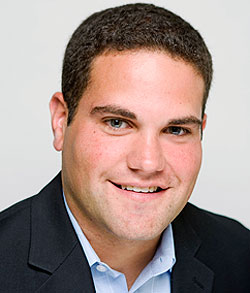Editor’s Note: This Q&A is part of “Newsroom Spotlight,” a series of conversations with journalists about what’s going on in their newsrooms and the media industry. The interview excerpts have been lightly edited and organized for clarity.
Ryan Sharrrow arrived at the Baltimore Business Journal in 2005, fresh out of Towson University with his journalism degree. He’s quickly climbed to managing editor, directing two editors, four reporters, a designer and a photographer in their 24/7 business coverage of Charm City.
His boss, editor in chief Joanna Sullivan, says, “We’re trying to reach busy business people who are on their mobile device. They don’t have a lot of time so it has to be clear.” While mobile is central to their strategy, so is perhaps the preferred method of business execs: newsletters. BBJ produces three free emails each day – general news in the morning and afternoon, and a popular real estate edition midday.
When it comes to the paper product, most of its content is “second- or third-day look” at the week’s top stories.
BBJ is part of Business Journals, a division of American City Business Journals, based in Charlotte, N.C.
American Journalism Review: What key experiments are currently underway in your newsroom?
Ryan Sharrow: We’re still learning to adapt to the model of putting all breaking news and exclusive stories online, as they happen. We redesigned the print edition in January 2014. The new-look paper allows us to better brand our reporters, who offer more analysis on the stories they broke throughout the week online.
AJR: Please describe any new websites (especially ones aimed at niche audiences) that your news organization has started in the last two years.
Sharrow: We’ve launched a few blogs over the past few years – one about cybersecurity and technology called TechFlash. We also launched a blog called Charm City Flavor that focuses on the hospitality scene. So we’re always thinking about niche-specific blogs that will have a good audience. We feel like if the audience is demanding news about a certain industry, we will answer with a specific blog.
AJR: Let’s talk mobile. How is your newsroom is approaching storytelling for mobile devices?
Sharrow: Reporters know that if they’re covering a press conference or big news event they should be tweeting comments and posting pictures. Back here in the newsroom, we have a lot of followers on our main account and we retweet the reporters’ posts to help grow their brand. Also we send out breaking news alerts and users who have downloaded our app will get a message story. Mobile is our fastest-growing platform for page views
AJR: Which media companies do you think are disrupting the news media landscape? How and why?
Sharrow: Business Insider does a really good job. They have a lot of good blogs. Vox has some really cool interactive features. The Wall Street Journal and the News York Times are doing some great things as well.
AJR: Describe the most innovative thing your newsroom has done in the last year.
Sharrow: The redesign of the print edition was a learning curve. We have a model called pinstripe, and we will break news into three or four stories throughout the day or week and give the readers a deeper look in print. We put a lot of emphasis on getting that first story up, and then we’ll meet and ask how we can keep the conversation going. Online metrics helps us determine what our audience is demanding.
AJR: What emerging technologies or storytelling methods are you trying to learn more about because they have the potential to impact news?
Sharrow: We continue to focus on how we get better at video. Visual elements are always very popular. One of the first things we discuss with every story is what visual elements we can use.
AJR:Describe the audience development efforts underway in your newsroom.
Sharrow: We use social media to interact with readers. People of all ages are on Facebook at all times of the day. On Twitter, we are posting four to five times an hour. Social media also helps us to capture a younger audience. We have one person who really focuses on it throughout the day.
AJR: How does your newsroom use analytics to make daily coverage decisions?
Sharrow: We look at analytics constantly. We look to see what’s generating a lot of buzz, what readers are clicking on and how long they’re staying on the story. That helps determine which follow-ups to pursue. I mentioned the 3 o’clock newsletter; when we put that together, we rank the stories and put them in order based on analytics.
AJR: Tell us about your newsroom’s social media efforts. Are all reporters required to use social media to promote their stories?
Sharrow: Yes. Reporters tweet from their own accounts, and it goes back to building their own brands.
AJR: What are your most successful efforts involving obtaining user-generated content for your website?
Sharrow: Baltimore has a lot of popular neighborhood message boards on Facebook. We get a lot of breaking news based on what people are saying is going on in their own neighborhoods.
AJR: Does your news organization hold events? If so, what types?
Sharrow: Our audience development team organizes events. We have about one a month tied to business networking and one a quarter tied to a special publication. We do 40 Under 40 every year where we choose 40 people under 40 to watch in the Baltimore area; we also do Best Places to Work, and a big event called Enterprising Women, which is a panel with four to five women talking about what’s going on in business. We get about 500 people to that one in August. So events are a big part of our business.
AJR: On a scale of 1-5, how optimistic are you about the future of news? 5 would be “very optimistic.”
Sharrow: I’d say 5. I’m very optimistic. I think we’re constantly learning how things are going to take shape since things have changed so dramatically over the last decade. But there’s always going to be a thirst for news. News itself will always be there – it’s just a matter of giving the people what they want.
University of Maryland student Katie Secret, who interviewed editor in chief Joanna Sullivan, contributed to this report.









